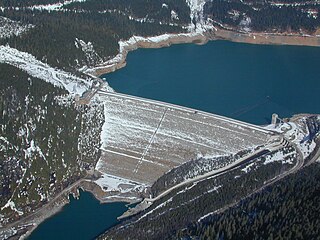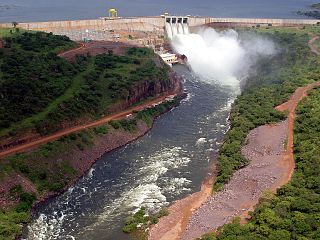
The Capanda Dam is a hydroelectric dam on the Kwanza River in Malanje Province, Angola. Built in 1987–2007 years the Russian company Tekhnopromexport, general designer - the institute Hydroproject The facility generates power by utilizing four turbines and 130 megawatts (170,000 hp) each, totalling the installed capacity to 520 megawatts (700,000 hp). Total cost of US$4 billion. An additional cost of more than US$400 million was spent in repairing the damage caused during UNITA's occupation of the area at the time of the Angolan Civil War in 1992 and 1999.

Kidatu Dam, also Kidadu Hydroelectric Power Sation is a 204 megawatts (274,000 hp) hydroelectric dam in Tanzania.

Run-of-river hydroelectricity (ROR) or run-of-the-river hydroelectricity is a type of hydroelectric generation plant whereby little or no water storage is provided. Run-of-the-river power plants may have no water storage at all or a limited amount of storage, in which case the storage reservoir is referred to as pondage. A plant without pondage is subject to seasonal river flows, thus the plant will operate as an intermittent energy source. Conventional hydro uses reservoirs, which regulate water for flood control and dispatchable electrical power.

Kaptai Dam is on the Karnaphuli River at Kaptai, 65 kilometres (40 mi) upstream from Chittagong in Rangamati District, Bangladesh. It is an earth-fill embankment dam with a reservoir water storage capacity of 6,477 million cubic metres (5,251,000 acre⋅ft). The primary purpose of the dam and reservoir was to generate hydroelectric power. Construction was completed in 1962. The generators in the 230 megawatts (310,000 hp) Karnafuli Hydroelectric Power Station were commissioned between 1962 and 1988. It is the only hydroelectric power station in Bangladesh.

The Gitaru Hydroelectric Power Station, also known as the Gitaru Dam, is a rock and earth-filled embankment dam on the Tana River in Kenya. It straddles the border between Embu and Machakos Counties in the Eastern Province. The primary purpose of the dam is hydroelectric power generation, and it supports a 225 megawatt power station. Construction on the dam began in 1975 and was completed in 1978. The third generating set, mobilising the full potential of the power station was not commissioned until 1999. US$63 million in funding for the project was provided by the World Bank. The station is operated by the Kenya Electricity Generating Company and is part of the Seven Forks Scheme.

The Dix Dam is a dam on the Dix River located between Mercer and Garrard County, Kentucky. It was constructed to generate hydroelectricity and prevent flooding of the Kentucky River but is better known for creating Herrington Lake.
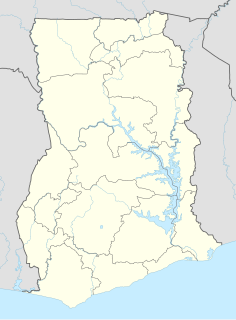
The Kpong Dam, also known as the Akuse Dam, is a hydroelectric power generating dam on the lower Volta River near Akuse in Ghana. It is owned and operated by Volta River Authority. It was constructed between 1977 and 1982. Its power station has a capacity of 148 megawatts (198,000 hp) with all four units running, though the total nameplate capacity is 160 megawatts (210,000 hp).

Isimba Hydroelectric Power Station is a 183.2 megawatts (245,700 hp) hydroelectric power station commissioned on 21 March 2019 in Uganda. Construction of this dam began in April 2015 and was completed in January 2019. Commercial operations began on 21 March 2019.
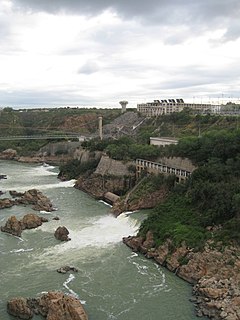
The Paulo Afonso Hydroelectric Complex, also known as the Paulo Afonso Complex, is a system of three dams and five hydroelectric power plants on the São Francisco River near the city of Paulo Afonso in Bahia, Brazil. The complex exploits an 80-metre (260 ft) natural gap on the river, known as the Paulo Afonso Falls. Constructed in succession between 1948 and 1979, the dams support the Paulo Afonso I, II, III, IV and Apollonius Sales (Moxotó) power plants which contain a total of 23 generators with an installed capacity of 4,279.6 megawatts (5,739,000 hp).
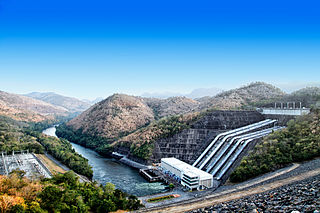
The Srinagarind Dam is an embankment dam on the Khwae Yai River in Si Sawat District of Kanchanaburi Province, Thailand. The purposes of the dam are river regulation and hydroelectric power generation. The dam's power station has a 720 megawatts (970,000 hp) capacity of which 360 megawatts (480,000 hp) is pumped storage. The dam was named after Princess Srinagarindra.
Lomaum Dam is a privately owned hydroelectric dam on the Catumbela River in the Benguela province of central Angola. Completed in 1965, it initially produced 20 megawatts (27,000 hp) of power, supplying electricity to the towns of Lobito, Benguela and Huambo. This dam was destroyed in 1983 by UNITA after Angola gained independence. This resulted in widespread flooding and the death of ten people. In 1987, Portugal provided credit for the rehabilitation of this structure. Plans for rehabilitation and enlargement to a capacity of 60 megawatts (80,000 hp) were made in 2008, with completion targeted for 2011.

The Punchiná Dam is an embankment dam on the Guatapé River 17 kilometres (11 mi) east of San Carlos in Antioquia Department, Colombia. The dam creates Punchiná Reservoir which is part of the 1,240 megawatts (1,660,000 hp) San Carlos Hydroelectric Power Plant. The power plant was completed in two 620 megawatts (830,000 hp) stages, the first was completed in 1984 and the second in 1987. It is the largest power station in Colombia.

Long Spruce Generating Station is a run-of-the-river hydroelectric dam on the Nelson River approximately 745 kilometres (463 mi) northeast of Winnipeg in the Canadian province of Manitoba.

The Rusumo Hydroelectric Power Station, also known as the Rusumo Power Station, is a hydropower plant under construction, with initial planned capacity installation of 80 megawatts (110,000 hp) when completed. The project will involve the construction of a dam, with run of river design. A more expensive 90 megawatts (120,000 hp) reservoir design was considered before being abandoned in favor of an 80 MW project with a smaller environmental impact and an estimated cost of US$300 million compared to US$400 million for the bigger project. The World Bank announced on 6 August 2013 that it had approved loans totaling US$340 million towards the US$468.60 million needed for the project. In November 2013, the African Development Bank approved a loan of US$113 million towards completion of the project.

Nyagak II Power Station is a 5 megawatts (6,700 hp) proposed mini hydroelectric power project in Uganda.

The Bumbuna Dam is a concrete-face rock-fill dam on the Seli River near Bumbuna in Tonkolili District, Sierra Leone, and 350 kilometres (220 mi) from the capital of Freetown, the main consumer. The country's first hydroelectric dam, it supports a 50-megawatt (67,000 hp) power station.
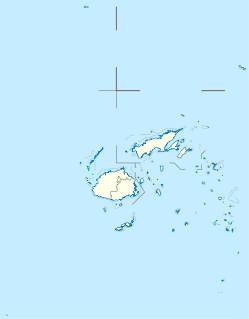
The Monasavu Dam is a rock-fill embankment dam on the Nanuku River about 60 kilometres (37 mi) northwest of Suva in Naitasiri Province, Fiji. It is located just above the Monasavu Falls and is both the tallest and largest dam, which also withholds the largest reservoir in the country. The primary purpose of the dam is to produce hydroelectric power and it supports an 80 megawatts (110,000 hp) power station. To offset fossil fuel imports for power production on the island, the Monasavu-Wailoa Hydroelectric Project was authorized by the Fiji Electricity Authority in 1977 and construction began in May 1978. The dam was complete and power station commissioned in 1983. About US$15 million of the project's total US$234 million cost was supplied by the World Bank, the rest by the host government and loans.

The Nadarivatu Dam, also known as the Korolevu Dam, is a concrete gravity dam on the upper reaches of the Sigatoka River in Nadarivatu District of Nadroga-Navosa Province, Fiji. The primary purpose of the dam is to generate hydroelectric power in a 41.7 megawatts (55,900 hp) run-of-the-river scheme. The Nadarivatu Hydropower Scheme was first identified in 1977 during a hydropower study. Details plans for the project were developed in 2002 and major construction began in 2009. The power station was commissioned on 7 September 2012 but an inauguration ceremony led by Prime Minister Frank Bainimarama was held a week later on 14 September. Funding and loans for the project was provided by several organizations to include the China Development Bank, Fiji Electricity Authority bonds, ADZ Bank. The 40 m (130 ft) tall dam diverts water from the Sigatoka River through a 3,225 metres (10,581 ft) long headrace/penstock tunnel to a power station along the Ba River to the southwest. The power station contains two 20.85 megawatts (27,960 hp) Pelton turbine-generators. The drop in elevation between the reservoir and the power station affords a gross hydraulic head of 335.7 metres (1,101 ft).
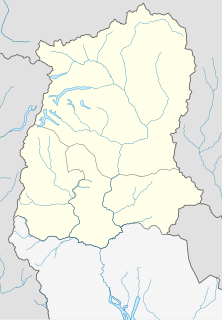
Jorethang Loop Hydroelectric project is a 96 megawatts (129,000 hp), run-of-the-river hydroelectric power station on the Rangit river in South Sikkim district of Sikkim state in India. The dam is located near village Piple and power station is located about 13 km downstream near village Majhitar. Dans Energy Private Limited was awarded contract for construction of the project. The project was officially inaugurated on 29 October 2015. The project was built at a cost of Rs 1,182 crores.
